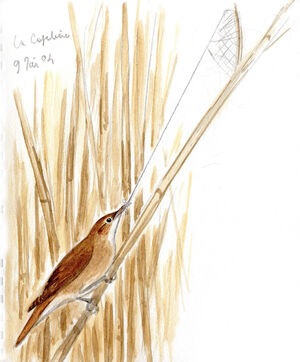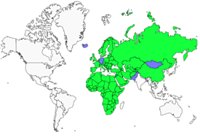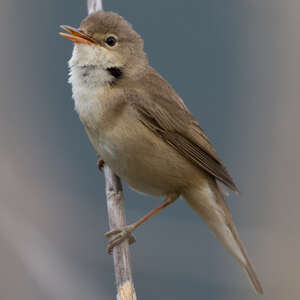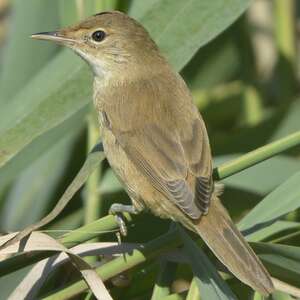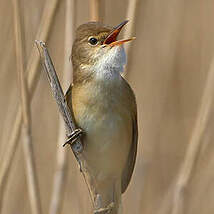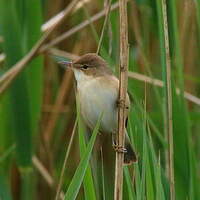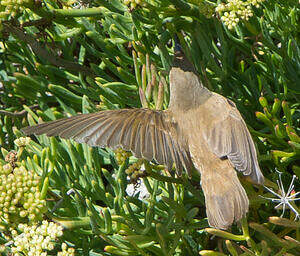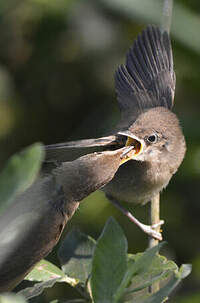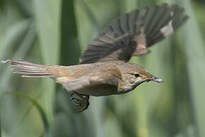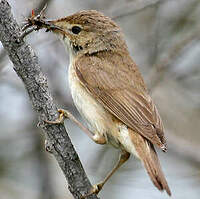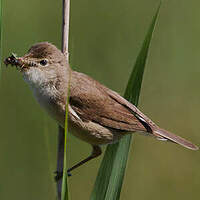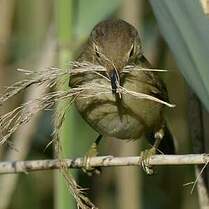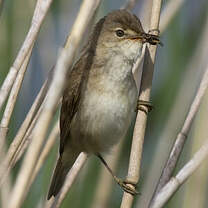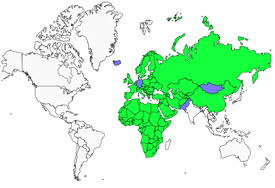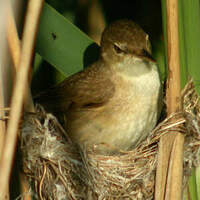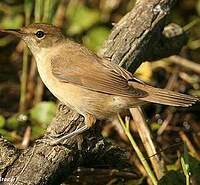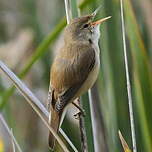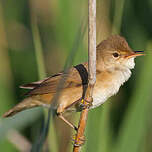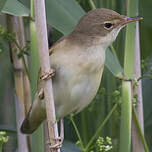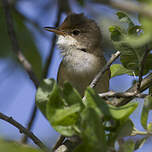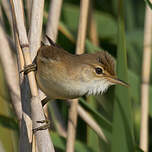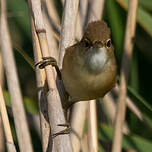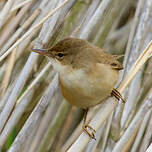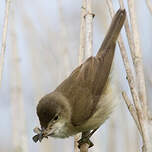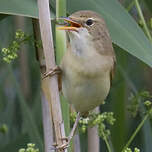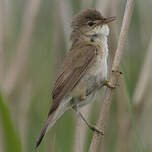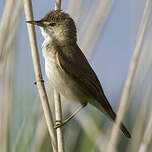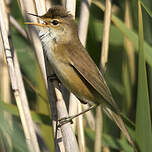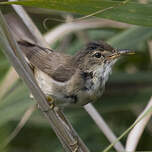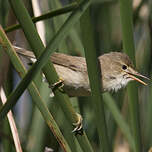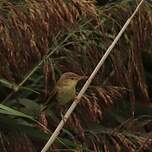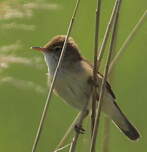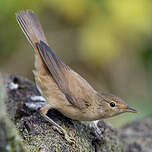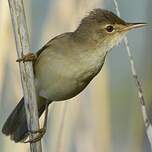Common Reed Warbler
Acrocephalus scirpaceus - Rousserolle effarvatte
Identification
The Common Reed Warbler is the most common of our aquatic warblers, which are recognized by their sharp profile (Acrocephalus), round tail at the end, and long undertail coverts. It frequents reed beds with phragmites during the breeding season.
Both sexes are identical.
In fresh plumage, the adult has quite warm upper parts, a dark, muted brown. A clear russet tone is visible on the lower back, rump, and coverts. The front of the crown is slightly darker. The pale fringes of the remiges contrast with the dark centers of these, breaking the uniformity of the plumage. The primary projection is medium, about equal to 2/3 of the length of the tertiaries. The short, cream-russet eyebrow, clear in front of the eye, does not continue behind or is indistinct. It is highlighted by the front of the crown, a little darker than the rest and underlined by a dark loreal line. The eye is surrounded by a white eye ring broken in front and in the back. The lower parts are light. The flanks and sides of the chest are strongly infiltrated with chamois. The throat is white, a character that appears well when singing. The underside of the wings, the axillars and the undertail coverts are chamois-cream. The upper mandible is dark horn gray while the lower mandible is of a more or less vivid yellow. The legs are of a brownish colour and appear dark on the ground. The plant of the feet is dull yellow. The iris is light brown.
In worn plumage (June-September for most birds), the adult upper parts become more grey-brown and the lower parts pale.
The juvenile has much redder new plumage than the adult and its legs are greyer. It then looks very much like the other young reed warblers, Verderolle in particular, which can lead to confusion.
Subspecific information 10 subspecies
- Acrocephalus scirpaceus scirpaceus (Europe to w Russia, Ukraine and w Turkey, nw Africa)
- Acrocephalus scirpaceus fuscus (n Egypt and c Turkey through the Middle East to se European Russia, n Iran, Kazakhstan and nw China)
- Acrocephalus scirpaceus avicenniae (coasts of the Red Sea)
- Acrocephalus scirpaceus ammon (Oasis along the Libya/Egypt border region.)
- Acrocephalus scirpaceus ambiguus ()
- Acrocephalus scirpaceus minor ()
- Acrocephalus scirpaceus cinnamomeus ()
- Acrocephalus scirpaceus suahelicus ()
- Acrocephalus scirpaceus hallae ()
- Acrocephalus scirpaceus baeticatus ()
Foreign names
- Rousserolle effarvatte,
- Carricero común,
- rouxinol-pequeno-dos-caniços,
- Teichrohrsänger,
- cserregő nádiposzáta,
- Kleine Karekiet,
- Cannaiola,
- rörsångare,
- Rørsanger,
- trsteniarik bahenný,
- rákosník obecný,
- Rørsanger,
- rytikerttunen,
- Hermansrietsanger,
- boscarla de canyar,
- Sefsöngvari,
- trzcinniczek (zwyczajny),
- ezeru ķauķis,
- srpična trstnica,
- Тростниковая камышевка,
- ヨーロッパヨシキリ,
- 芦苇莺,
- 蘆葦鶯〔歐葦鶯〕,
Voice song and cries
The song of the Common Reed Warbler is quite typical. Monotonous compared to that of other warblers, it consists of a long series of short syllables, which are scratched or whistled and repeated tirelessly with little variation. Some males (more talented than others?) occasionally improvise or introduce some imitations, especially in sympatry with the congener the Fan-tailed Warbler, but the Reed Warbler rhythm invariably reappears.
Habitat
The Common Reed Warbler is a resident of the flooded Phragmites that borders still or flowing water, or invades marshy areas.
Behaviour character trait
Common Reed Warbler pairs are territorial. Despite this, the density is often so high in reedbeds that the species is distributed almost semi-colonially. The male sings perched in sight in the upper part of a dry reed, while the female is busy with nesting activities. The birds move from stem to stem clinging to them sideways as all marshland passerines do, or else they take short flights from one massif to another. They move up and down agilely along the stems, going from one to the other in search of food. They are insectivorous, hunting insects in view in the wetlands or in the adjacent environments, such as crops or cleared land.
It is also less linked to water and can be observed in different environments, including shrubs, where it betrays its presence with tec of anxiety, and sometimes with song strophes.
The Common Reed Warbler is a great migrator that spends the boreal winter in sub-Saharan Africa south of the Sahara. It begins its migration at the end of August or the beginning of September. At this time, the young ones can fly well and have had enough time to gain enough weight to be able to make the big journey that awaits them. Our birds fly over the Mediterranean, then the arid regions of North Africa and finally reach the wet areas of sub-Saharan Africa, where they renew their worn plumage and find a lot of insects. This journey will take them about two months. Two months later, they'll already have to think about the return journey that will bring them back to Europe in mid-April. The adults return to the same nesting site each year, while the young ones are less loyal and ensure a genetic mix of the population.
Dietfeeding habits
The Common Reed Warbler feeds on arthropods, primarily insects found among the reeds. Aquatic larval insects near the water, ephemeral, caddisfly, beads and mayflies are common prey for the Common Reed Warbler.
It also preys on various diptera, spiders and when there is a population of aphids in the phragmites, the warbler takes advantage of them despite their small size. Occasionally, during migration, it can also consume berries. At the end of summer, before leaving for Africa, the Common Reed Warbler stores fat to prepare it for its long migration journey. The signal to migrate is set by an internal clock, which itself is influenced by the length of the day.Reproduction nesting
The Common Reed Warbler nesting season begins when the female arrives on the male's territory at the end of April or in May.
The female builds the nest, while the male follows while defending the territory against rivals - either using his voice or in pursuit. The nest is a carefully built structure of dry grasses, tied to some smooth vertical stems of dry phragmites. The completed nest is a cylindrical structure with a raised edge, lined with plant hair and rootlets. The female usually lays 4 to 5 bluish and speckled eggs. Both the male and female incubate the eggs, with the female having a brood patch. After about eleven or twelve days of incubation, the eggs hatch. Fed on insects by both parents, the chicks grow rapidly and are fully feathered and ready to fly about ten days later. In more favourable plain or southern regions, the female can have two broods in one season - a rare occurrence in northern or high altitude regions.The Common Reed Warbler is frequently parasitized by the Common Cuckoo. If this is the case, the reed warbler's chicks will be lost in favour of the young cuckoo, who will be fed by its 'adoptive' parents.
Geographic range
It is the most widespread warbler in Europe. It has a vast distribution area from the Atlantic in the west to the outer reaches of China in the east and from southern Scandinavia in the north to Iran in the south, touching on North Africa. Despite this, there are only two subspecies, scirpaceus, to which the European population belongs, and fuscus, with a slightly cooler plumage, from Turkey to Kazakhstan.
Threats - protection
IUCN conservation status
concern
in the Wild
threatened
evaluated
The Common Reed Warbler is not threatened in the medium-term. Locally, intensive fisheries practices (draining of ponds, burning of reed beds, extensive mowing) can be detrimental by limiting its breeding habitat, Phragmites. Boat traffic can also degrade the riparian reed beds where it lives.
Sources of information
- IOC World Bird List (v14.1), Gill, F and D Donsker (Eds). 2023.
Other sources of interest
 Specification sheet created on
21/07/2023 by Jean François
Specification sheet created on
21/07/2023 by Jean FrançoisTranslation by AI Oiseaux.net
published: 23-09-2015 - Updated: 23-09-2015
© 1996-2024 Oiseaux.net
- Accipitriformes
- Aegotheliformes
- Anseriformes
- Apodiformes
- Apterygiformes
- Bucerotiformes
- Caprimulgiformes
- Cariamiformes
- Casuariiformes
- Charadriiformes
- Ciconiiformes
- Coliiformes
- Columbiformes
- Coraciiformes
- Cuculiformes
- Eurypygiformes
- Falconiformes
- Galliformes
- Gaviiformes
- Gruiformes
- Leptosomiformes
- Mesitornithiformes
- Musophagiformes
- Nyctibiiformes
- Opisthocomiformes
- Otidiformes
- Passeriformes
- Pelecaniformes
- Phaethontiformes
- Phoenicopteriformes
- Piciformes
- Podargiformes
- Podicipediformes
- Procellariiformes
- Psittaciformes
- Pterocliformes
- Rheiformes
- Sphenisciformes
- Steatornithiformes
- Strigiformes
- Struthioniformes
- Suliformes
- Tinamiformes
- Trogoniformes

